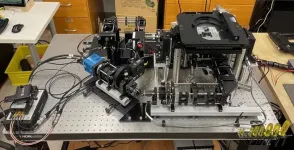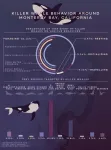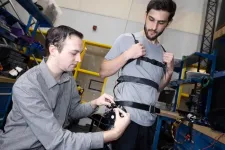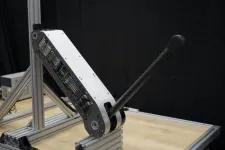EMBARGOED FOR RELEASE UNTIL 4 P.M. ET, WEDNESDAY, MARCH 20, 2024
MINNEAPOLIS – People who have an influenza infection are more likely to need medical care for neurologic disorders within the next year than people who have a COVID-19 infection, according to a study published in the March 20, 2024, online issue of Neurology®, the medical journal of the American Academy of Neurology. The study, funded by the American Academy of Neurology, looked at people who were hospitalized with either influenza or COVID-19. The study did not look specifically at outcomes associated with long COVID.
“It’s important to note that our study did not look at long COVID outcomes, and our results do not necessarily conflict with the findings in other research showing an increase in neurologic symptoms in people with long COVID,” said study author and Chair of the American Academy of Neurology’s Health Services Research Subcommittee Brian C. Callaghan, MD, MS, FAAN, of University of Michigan Health in Ann Arbor. “While the results were not what we expected to find, they are reassuring in that we found being hospitalized with COVID did not lead to more care for common neurologic conditions when compared to being hospitalized with influenza.”
For the study, researchers used healthcare claims data to compare 77,272 people who were hospitalized with COVID-19 to the same number of people who were hospitalized with influenza. Then they looked to see how many of those people had medical care within the following year for the any of the six most common neurologic disorders—migraine, epilepsy, stroke, neuropathy, movement disorders and dementia.
The researchers also looked at the people without those conditions at the start of the study to see how many developed a new diagnosis for any of the six conditions during the following year.
People who had a COVID-19 infection were less likely to need care in the following year for common neurologic conditions than people who had an influenza infection. Of those with COVID, 2.0% received care for migraine compared to 3.2% of those with influenza, and 1.6% of those with COVID received care for epilepsy compared to 2.1% of those with influenza. For neuropathy, the numbers were 1.9% and 3.6%; movement disorders were 1.5% and 2.5%; stroke was 2.0% and 2.4%; and dementia was 2.0% and 2.3%.
Once researchers adjusted for other factors that could affect the need for care, such as age, sex and a number of other health conditions, they found that those with a COVID infection had a 35% lower risk of receiving care for migraine than people who had influenza. Those with COVID had a 22% lower risk of receiving care for epilepsy and a 44% lower risk of receiving care for neuropathy. They also had a 36% lower risk of receiving care for movement disorders, a 10% lower risk for stroke and a 7% lower risk for dementia.
When researchers looked to see who developed new neurologic conditions in the year after infection, they found that 2.8% of those with COVID developed one of the six neurologic conditions, compared to 4.9% of those who had influenza.
“Since COVID-19 has now infected the majority of adults in the US, it’s good news that it behaves similarly to other respiratory viruses with respect to these common neurologic conditions,” said study author Adam de Havenon, MD, MSc, of Yale University in New Haven, Connecticut, and a member of the American Academy of Neurology Health Services Research Subcommittee. “There was concern that the already limited access to neurologic care would further shrink if we had a dramatic increase in neurologic care after COVID-19 infection.”
A limitation of the study is that the data platform the researchers used is not a nationally representative sample, so the results cannot be broadly generalized to all COVID-19 survivors in the United States.
The study was supported by the American Academy of Neurology.
Learn more about brain health at BrainandLife.org, home of the American Academy of Neurology’s free patient and caregiver magazine focused on the intersection of neurologic disease and brain health. Follow Brain & Life® on Facebook, Twitter and Instagram.
When posting to social media channels about this research, we encourage you to use the hashtags #Neurology and #AANscience.
The American Academy of Neurology is the world's largest association of neurologists and neuroscience professionals, with over 40,000 members. The AAN’s mission is to enhance member career fulfillment and promote brain health for all. A neurologist is a doctor with specialized training in diagnosing, treating and managing disorders of the brain and nervous system such as Alzheimer's disease, stroke, concussion, epilepsy, Parkinson's disease, multiple sclerosis, headache and migraine.
For more information about the American Academy of Neurology, visit AAN.com or find us on Facebook, Twitter, Instagram, LinkedIn and YouTube.
END
Is the burden of neurologic disease higher after influenza or COVID-19?
2024-03-20
(Press-News.org)
ELSE PRESS RELEASES FROM THIS DATE:
Scientists find one of the most ancient stars that formed in another galaxy
2024-03-20
The first generation of stars transformed the universe. Inside their cores, simple hydrogen and helium fused into a rainbow of elements. When these stars died, they exploded and sent these new elements across the universe. The iron running in your veins and the calcium in your teeth and the sodium powering your thoughts were all born in the heart of a long-dead star.
No one has been able to find one of those first generation of stars, but scientists have announced a unique finding: a star from the second generation that originally formed in a different galaxy from ours.
“This ...
Researchers add swept illumination to open-top light-sheet microscope
2024-03-20
Researchers have incorporated a swept illumination source into an open-top light-sheet microscope to enable improved optical sectioning over a larger area of view. The advance makes the technique more practical for nondestructive 3D pathology.
3D pathology is being explored as an alternative to traditional slide-based histology because it can provide detailed 3D insights into pathological structures and cellular interactions without altering the tissue. This approach makes it possible to analyze complex 3D tissue structures and to image thick tissues, which is not possible with slide-based methods.
The researchers used their improved open-top ...
High-quality microwave signals generated from tiny photonic chip
2024-03-20
In a new Nature study, Columbia Engineering researchers have built a photonic chip that is able to produce high-quality, ultra-low-noise microwave signals using only a single laser. The compact device — a chip so small, it could fit on a sharp pencil point — results in the lowest microwave noise ever observed in an integrated photonics platform.
The achievement provides a promising pathway towards small-footprint ultra-low-noise microwave generation for applications such as high-speed communication, atomic clocks, and autonomous vehicles.
The challenge
Electronic devices for global navigation, wireless communications, radar, and ...
OFC 2024 brings innovations from leading global organizations and cutting-edge tech demonstrations to California
2024-03-20
SAN DIEGO—A wave of innovation is hitting California as the Optical Fiber Communications Conference and Exhibition (OFC) gears up to showcase the latest breakthroughs in optical communications and networking.
OFC will take place at the San Diego Convention Center from 24 to 28 March 2024 drawing industry leaders, experts, academia, media, analysts and students from around the world to explore the latest in optical technology.
Innovative advancements in industrial technologies, as well as research in 800ZR, Coherent PON, Linear Pluggable Optics (LPO), multicore fiber, AI and ...
Killer whales use specialized hunting techniques to catch marine mammals in the open ocean
2024-03-20
Killer whales foraging in deep submarine canyons off the coast of California represent a distinct subpopulation that uses specialized hunting techniques to catch marine mammals, Josh McInnes at the University of British Columbia and colleagues report March 20 in the open-access journal PLOS ONE.
Killer whales (Orcinus orca) are found in oceans around the world, but they form separate populations, or ‘ecotypes’, that have their own social structure, food preferences and hunting behaviors. One ecotype, known as transient killer whales, specialize in hunting marine ...
The first Neolithic boats in the Mediterranean
2024-03-20
More than 7,000 years ago, people navigated the Mediterranean Sea using technologically sophisticated boats, according to a study published March 20, 2024 in the open-access journal PLOS ONE by Juan F. Gibaja of the Spanish National Research Council, Barcelona and colleagues.
Many of the most important civilizations in Europe originated on the shores of the Mediterranean Sea. During the Neolithic, communities clearly traveled and traded across the water, as evidenced by watercraft in the archeological record and the presence ...
Universal controller could push robotic prostheses, exoskeletons into real-world use
2024-03-20
Robotic exoskeletons designed to help humans with walking or physically demanding work have been the stuff of sci-fi lore for decades. Remember Ellen Ripley in that Power Loader in Alien? Or the crazy mobile platform George McFly wore in 2015 in Back to the Future, Part II because he threw his back out?
Researchers are working on real-life robotic assistance that could protect workers from painful injuries and help stroke patients regain their mobility. So far, they have required extensive calibration and context-specific tuning, which keeps them largely limited to research labs.
Mechanical engineers at Georgia Tech ...
Autism acceptance varies across countries – where should we target support?
2024-03-20
Societal acceptance of autism varies considerably across different countries, with lowest levels of acceptance found in Japan and Belgium, new research shows.
A survey of 306 autistic individuals from eight countries revealed that around three quarters of respondents do not feel accepted, or only sometimes feel accepted, as an autistic person. Among these countries, participants in Japan and Belgium reported the lowest levels of acceptance, while those in Canada, the UK, and South Africa reported comparatively higher levels.
The study, published in PLOS ONE, is the ...
A replacement for traditional motors could enhance next-gen robots
2024-03-20
Whether it’s a powered prosthesis to assist a person who has lost a limb or an independent robot navigating the outside world, we are asking machines to perform increasingly complex, dynamic tasks. But the standard electric motor was designed for steady, ongoing activities like running a compressor or spinning a conveyor belt – even updated designs waste a lot of energy when making more complicated movements.
Researchers at Stanford University have invented a way to augment electric motors to make them much more efficient at performing dynamic ...
Icy impacts: Planetary scientists use physics and images of impact craters to gauge the thickness of ice on Europa
2024-03-20
WEST LAFAYETTE, Ind. — Sometimes planetary physics is like being in a snowball fight. Most people, if handed an already-formed snowball, can use their experience and the feel of the ball to guess what kind of snow it is comprised of: packable and fluffy, or wet and icy.
Using nearly the same principles, planetary scientists have been able to study the structure of Europa, Jupiter’s icy moon.
Additional Information
When worlds collide: Studying impact craters to uncover the secrets of the solar system
Breaking in a new planet
Purdue scientists and engineers push the boundaries of space knowledge, studying the ...






